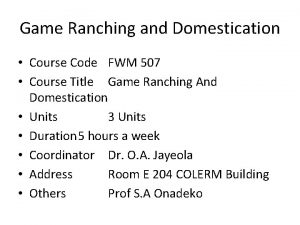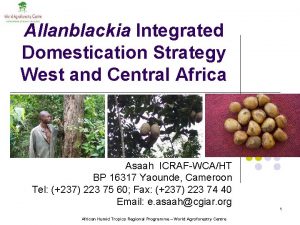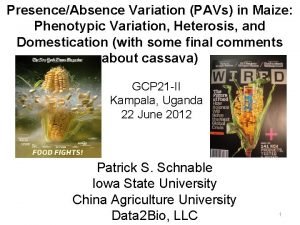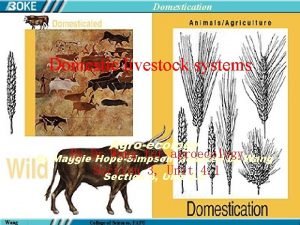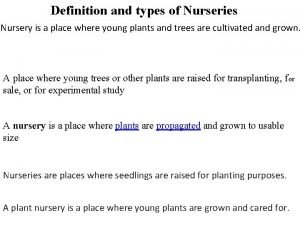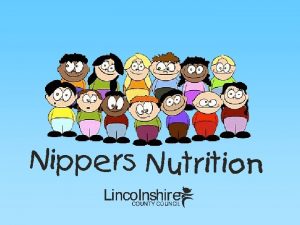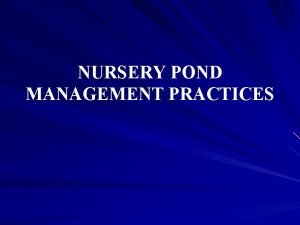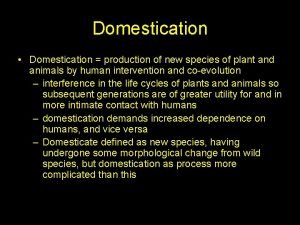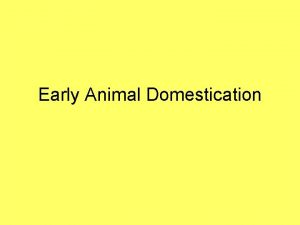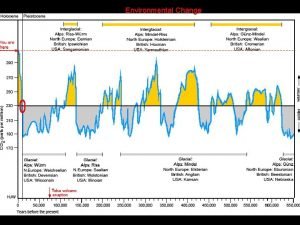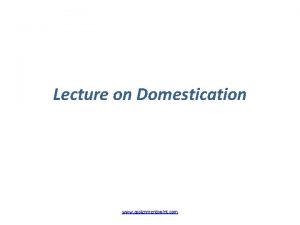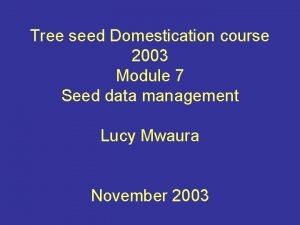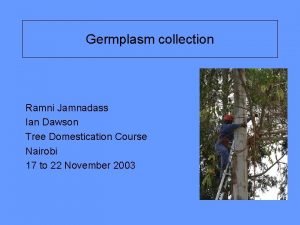Onfarm tree nurseries for Tree Domestication Jonathan Muriuki













- Slides: 13

On-farm tree nurseries for Tree Domestication Jonathan Muriuki

On-farm tree nurseries; Overview • Why focus on on-farm tree nurseries ? • Nursery categories • Constraints and points of intervention • Research questions • Challenges • Nursery associations

Why focus on the on-farm tree nurseries ? • Vital information to tree domestication (species diversity, supply and demand, improvement value) • Seedling distribution and marketing strategies • Support on-going research (type 2 & 3 on-farm species trials, nursery experiments) • Quality seedling production on-farm to reflect true species/provenance potential • Income generation to alleviate poverty • Tree nursery operators as extension agents

Nursery categories Generalist Vs specialist • Ease of propagation (seed pretreatment, vegetative propagation techniques) • Area of specialisation (indigenous species or exotic, fruit, timber etc)

Central nurseries • Operated by organisations (schools, NGOs, research projects, private companies) • Staff directly employed or re-deployed hence impressive • Differ depending on institutional capacity (BAT vs a primary school) • Necessary for production of difficult and long-term species (often specialist) • Disadvantages - transport of seedlings, distribution of benefits, cash-flow fluctuations

Group nurseries • Mainly overflows of other group activities • Seen as part of social activities • Different forms e. g central group nursery or several satellite nurseries or each member has own nursery under common leadership • Generate income but rarely make profit • Good for on-farm trials especially in members farms • Constant group disintegration effects • Members use left-overs which reflect poorly

Individual (private) nurseries • Privately managed for sale or private use • More enterprising with seeds purchased and seedlings sold hence good indicators of germplasm delivery pathways • More species diversity for a basketful of options to clients (often generalist) • More competitive meaning high seedling quality but also more variable

Nursery constraints and points of intervention • Lack of basic information training and follow-up, nursery associations, collaboration links with other agencies • Germplasm supply minimal seed supply, supply information on seed dealers, contracts for onfarm seed production

Constraints cont. . • Inputs - information and cheap alternatives especially water • Marketing of seedlings Link to users of seedlings where possible, nursery associations, linkages with other agencies, training on marketing and entrepreneurship

Research Questions • How many nurseries do we need in a landscape ? • How do we address some of the constraints ? - MSc studies etc • Technical questions -Seed and seedling quality issues • Socio-economic questions - community action and marketing issues

Some challenges to development of on-farm nurseries • Community dynamics varying binding factors in community (group dynamics, nursery associations) • Operator frustrations – natural calamities, some manage, some fail; attitudes • Balance between research and development

Nursery associations • The nursery fashion of farmer co-operatives as an idea of the project • Allow transparency and better information sharing on demand forecast, bulk orders, new species, seed sources etc • Channels for collaboration and training • Share financial and marketing information • Sourcing within network • Networking with seed dealers / suppliers

Developing nursery associations Support in form of extension visits, seeds, input packages and training Group nurseries Groups break up Little support but generate Individual nurseries income - little entrepreneurial skills Link through workshops, Networks link to bulk meetings etc demand, seed sources, Nursery associations training and information on new species & markets - Area specific scale and mode of development
 Fwm game
Fwm game Domestication
Domestication Domestication
Domestication Schleiermacher on the different methods of translating
Schleiermacher on the different methods of translating Domestication of animals
Domestication of animals Nursery beds meaning
Nursery beds meaning Nippers food
Nippers food Pirouette growth regulator
Pirouette growth regulator Management of nursery rearing and stocking ponds
Management of nursery rearing and stocking ponds Rutin för avvikelsehantering
Rutin för avvikelsehantering Myndigheten för delaktighet
Myndigheten för delaktighet Presentera för publik crossboss
Presentera för publik crossboss Fspos
Fspos Klassificeringsstruktur för kommunala verksamheter
Klassificeringsstruktur för kommunala verksamheter
